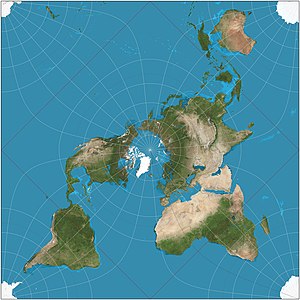
Back Quincunx-Kartenprojektion German パース・クインカンシャル図法 Japanese Projeção quincuncial de Peirce Portuguese


The Peirce quincuncial projection is the conformal map projection from the sphere to an unfolded square dihedron, developed by Charles Sanders Peirce in 1879.[1] Each octant projects onto an isosceles right triangle, and these are arranged into a square. The name quincuncial refers to this arrangement: the north pole at the center and quarters of the south pole in the corners form a quincunx pattern like the pips on the five face of a traditional die. The projection has the distinctive property that it forms a seamless square tiling of the plane, conformal except at four singular points along the equator.
Typically the projection is square and oriented such that the north pole lies at the center, but an oblique aspect in a rectangle was proposed by Émile Guyou in 1887, and a transverse aspect was proposed by Oscar Adams in 1925.
The projection has seen use in digital photography for portraying spherical panoramas.
- ^ A Quincuncial Projection of the Sphere by Charles Sanders Peirce. 1890.
I. Frischauf. Bemerkungen zu C. S. Peirce Quincuncial Projection. (Tr., Comments on C. S. Peirce Quincuncial Projection.)
A Treatise on Projections by Thomas Craig. U.S. Government Printing Office, 1882. p 132
Science, Volume 11. Moses King, 1900. p 186
© MMXXIII Rich X Search. We shall prevail. All rights reserved. Rich X Search